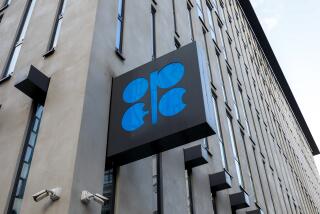Industry Expects Demand to Be Flat : Crude Oil Price May Fall Another $1-$2
- Share via
As flat demand for petroleum products continues, crude oil prices will drop by another $1 to $2 a barrel by next spring, major oil industry executives now believe.
The continued slump is likely to hold oil industry earnings at 1985 levels and, “if it varies, 1986 will be worse,” said George M. Keller, chairman and chief executive of Chevron.
The executives made their comments last week while attending the annual meeting of the American Petroleum Institute in San Francisco. Although most expect oil prices eventually to recover, the executives predicted that the industry faces another year of too much oil and too little demand for refined petroleum products, especially gasoline.
The industry executives’ forecast that the price of crude oil will range between $25 and $26 per barrel is less severe than some Wall Street estimates, which generally range from $20 to $25 a barrel. The lowest estimate of next year’s prices has been offered by Saudi Arabia’s oil minister, Ahmed Zaki Yamani, who said oil prices would fall to $18 a barrel unless oil-producing countries, including fellow Organization of Petroleum Exporting Countries members, reduce production.
Since Yamani made that forecast in October, however, Saudi Arabia has increased its production to 3.8 million to 4 million barrels daily this month from 2.2 million barrels a day in June. Saudi Arabia’s quota under current OPEC rules is 4.3 million barrels daily.
Despite the expectations of price drops, however, prices have been higher recently for oil sold on the “spot,” or non-contract, market. But analysts say those increases are due solely to seasonal demand, which is greater in the fall as refineries build stocks for the winter heating season. This year, stocks of crude oil are at their lowest levels since 1979, analysts say, heightening the seasonal demand for crude oil. Saudi Light, the OPEC benchmark crude oil, is trading at $27.90 a barrel on the spot market, compared to $27.05 in July.
Few Expect OPEC to Exceed Quota
Keller acknowledged that, “if OPEC decided to sell more barrels” beyond the winter season, “there probably isn’t a bottom to prices.” But few executives now expect OPEC to exceed its self-imposed production limit of 16 million barrels a day. For one thing, Keller said, there isn’t a market for any more oil.
“What we’ve learned is that demand responds very slowly to price. The industry will start to substitute oil for coal at around $10 to $15 a barrel, and only if they think those prices will last,” he said.
Ralph E. Bailey, chairman and chief executive of Conoco, said the real question is “who is going to lead prices down? I don’t think producing countries are going to shoot themselves in the foot.” Bailey, who said he isn’t among those who are “super-pessimistic,” said he expects some “resistance” once prices reach $25 per barrel.
Bailey said “one large question mark” is the continued improvement in the refining and marketing side of the business, which consists primarily of gasoline production and sales. The industry was able to keep stocks fairly low this year, resulting in fairly stable gasoline prices in most of the nation.
Keller said that, if the national economy remains healthy, “there’s a possibility of a slight uptick” in refining and marketing income as a result of massive cutbacks that the industry has made in the number of gas stations and refineries. Chevron recently sold a network of 4,000 Northeastern stations. That uptick, he said, might compensate for further “softness” in crude oil prices.
Flat prices mean a flat year for exploration since “there is almost a direct relationship between the price of oil and the amount of holes drilled,” Bailey said. The API reported that oil and gas exploration was down 5.6% for the third quarter of 1985 from the same period a year ago. “Spending for exploration industrywide is now $32 billion, compared to $55 billion only a few years ago,” said John F. Bookout, president and chief executive of Shell Oil.
Bookout said Shell will spend $4 billion on exploration next year, about what it is spending in 1985, but “we will be deferring opportunities in natural gas.”
Natural gas prices have dropped by about 30% since January, and “there’s a distinct possibility we’ll see more price erosion,” Bailey said. Recently, the Energy Department estimated that there is between 3 trillion and 4 trillion cubic feet of gas available that isn’t being produced, enough to supply California’s needs for the next two to three years.
More to Read
Inside the business of entertainment
The Wide Shot brings you news, analysis and insights on everything from streaming wars to production — and what it all means for the future.
You may occasionally receive promotional content from the Los Angeles Times.










